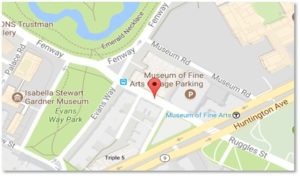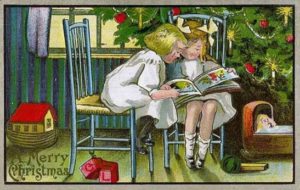Louis Prang Street runs along the west side of the School of the Museum of Fine Arts, paralleling Museum Road on the east side, as well as just east of the Massachusetts College of Art and south of the Isabella Stewart Gardner museum.
So, who was Louis Prang and what did he accomplish that caused the city to name a road in the Museum District for him?
Researching this question turned up one of those fascinating stories about a person of merit and value, now lost to history but whose accomplishments have touched our modern lives.
Louis Prang: Immigrant Entrepreneur
Louis Prang came to Boston in 1856, the same year that Boston proclaimed Christmas as a legal holiday. (The Puritans had banned it as a pagan celebration overlain by a thin veneer of Christianity.) The synchronicity of this date will become obvious later.
Born in Breslau, Germany, of a French Huguenot father and a German mother, he apprenticed in his father’s textile manufacturing business, learning engraving, textile dying, and calico printing. Mr. Prang traveled around Bohemia for his work in printing and textiles but in 1848 became in involved in Germany’s March Revolution. The Prussian Government chased him into Switzerland and he emigrated to Boston two years later.
Here he worked in publishing architectural books and making leather goods but these efforts were not successful and he turned to carving wood engravings for book illustrations. The following year he went to work for Frank Leslie, the art director for Gleason’s Pictorial Drawing-Room Companion.
In 1856, Mr. Prang and a partner founded the lithographic firm of Prang and Mayer, which specialized in prints of buildings and towns in Massachusetts. This became L. Prang and Company when he bought out his partner in 1860.
L. Prang and Company in Roxbury
The print shop, located in front of Mr. Prang’s house on Centre Street in Roxbury, produced color advertisements and business materials but was best known for war maps printed during the Civil War and distributed in newspapers, as well as reproductions of famous works of art.
Mr. Prang returned to Europe in 1864 to spend a year learning about cutting-edge German lithography. The bright colors produced by the new chromolithographic process revolutionized the printing business. When he returned, he added high-quality reproductions of major art works to the company’s products. His chromolithographs simulated the textures and richness of oil painting and are of such high quality that they can fool the untrained viewer into thinking they are oil paintings.
Here’s how the New York Historical Society describes it:
“At the time, most lithographers printed black and white lithographs which were then hand colored. Chromolithography involved creating a litho stone plate for each of the colors to be printed. Some prints required up to twenty plates to create the intense color and gradation Prang envisioned. It was a costly and labor-intensive process, but the quality was unmatched, and for Prang, who considered his “chromos” works of art, nothing less would do.”
This allowed middle-class families to put colorful, attractive artworks on the walls—a luxury once known only to the rich—and add some culture to their homes. These prints included religious art, Hudson River School paintings, still lifes, hunting scenes, landscapes, and animal paintings.Mr. Prang featured his company’s chromolithographs in “Prang’s Magazine; A Journal of Popular Art.”
Merry Christmas from Louis Prang
Louis Prang is best known, however, as the “Father of the American Christmas Card.”
After producing collectible “album cards,” popular in the Victorian era, the company created Christmas cards for the British market in 1873. They introduced them to American the following year and L. Prang and Co. became the first printers to make commercially printed holiday greeting cards available to the public in this country.
This effort was highly successful and by 1881 the company reportedly was printing five million Christmas cards a year. The first products were simple but they grew more complex and some included silk tassels, cords and fringe.
Mr. Prang also created a competition for artists to design Christmas cards that ran from 1880 to 1884. He made it worth their while to compete with sizable prizes. Artists winning the top four designs could make $1,000, $500, $300 and $200. In today’s money that translates to $29,245, $13,546, $8,774, and $5,849 respectively. The winners could buy some very nice Christmas presents with those sums.
He made sure that the judges knew their stuff by recruiting artists like John LaFarge and Samuel Colman, architect Stanford White, and designer Louis Comfort Tiffany. A stickler for quality, he exited the Christmas card business when cheap German cards flooded the market.
A Man Ahead of His Time
An active supporter of women artists, Mr. Prang collected and commissioned pieces done by women and many of his lithographs featured the works of female artists, including Ellen Thayer Fisher and Fidelia Bridges. He may have been influenced by Louis Comfort Tiffany, who also employed women in his decorative stained glass business. By 1881 L. Prang and Co. employed more than 100 women.
Prang and Co. merged with another firm in 1897 to create the Taber-Prang Company, which moved to Springfield, MA. It filed for bankruptcy in 1938. The original building still stands in Roxbury, however.
Louis Prang and Art Education
Louis Prang was a driving force behind providing public-school students with an art education. He wrote several text books on art instruction, natural history illustrations, and art education. Louis Prang founded the Prang Educational Company to publish books for art instruction in schools and the Prang Normal Art School, which was located on Bartlett Street in Roxbury.
Mr. Prang died in 1909 while on vacation in Los Angeles and is buried in Forest Hills Cemetery in Jamaica Plain.
Better Than Currier and Ives
Louis Prang was the most famous Boston lithographer in the second half of the 19th century and his prints, to my eye, are more colorful detailed, attractive and varied than those of the better-known Currier and Ives. You can see for yourself on the American Antiquarian Society’s online exhibition of his works
 Many are in the collection of the Boston Public Library and the Boston Museum of Fine Arts. If you find a chromolithograph in Grandma’s attic, don’t throw it out. She may well have had one of his “Home Sweet Home” samplers on the wall. Skinner’s Auctioneers sells his chormolithographs and they bring from two to four figures apiece.
Many are in the collection of the Boston Public Library and the Boston Museum of Fine Arts. If you find a chromolithograph in Grandma’s attic, don’t throw it out. She may well have had one of his “Home Sweet Home” samplers on the wall. Skinner’s Auctioneers sells his chormolithographs and they bring from two to four figures apiece.
Now we know why it’s appropriate to have a street named for Louis Prang in the Museum District. Given what he contributed to art in America, I think there should be a street fair in his honor every year so more people would know.
Louis Prang Street runs from the Fenway to Huntington Avenue, after which it becomes Ruggles Street.




